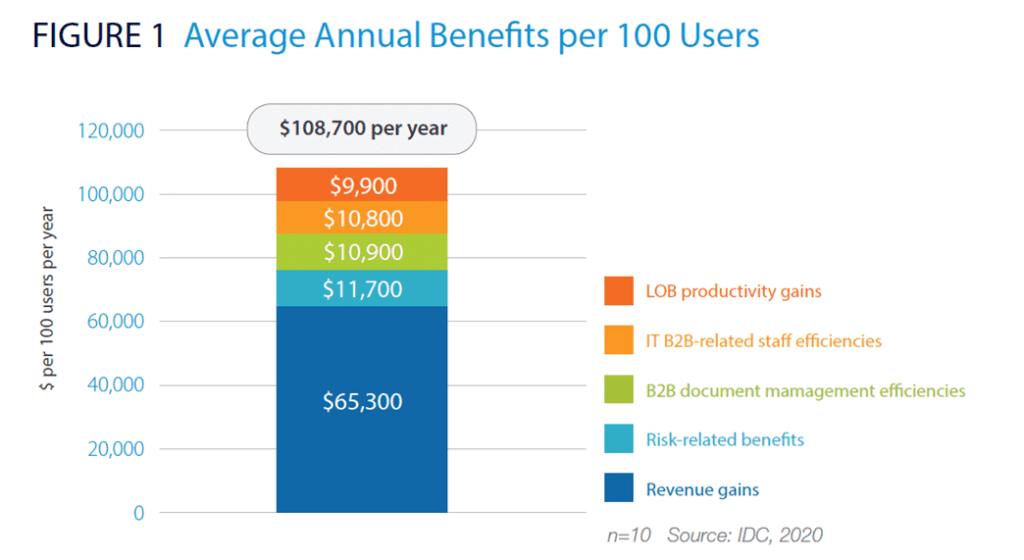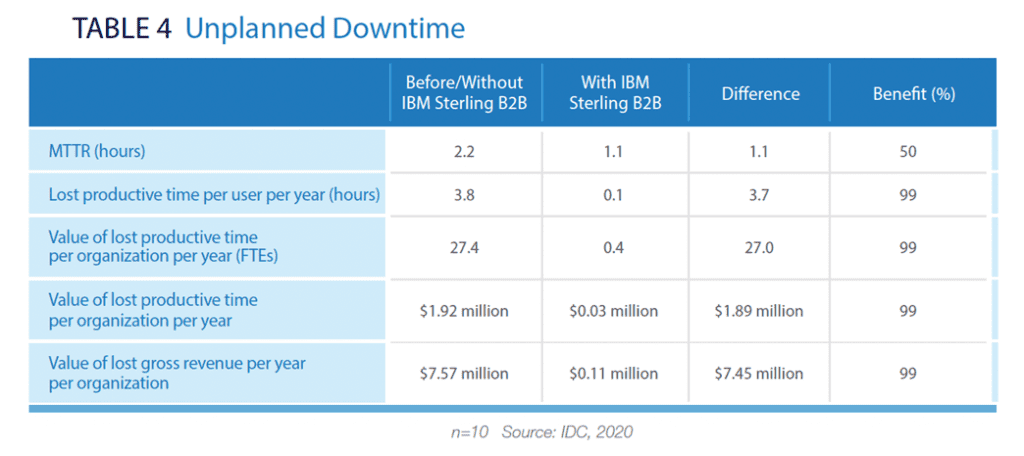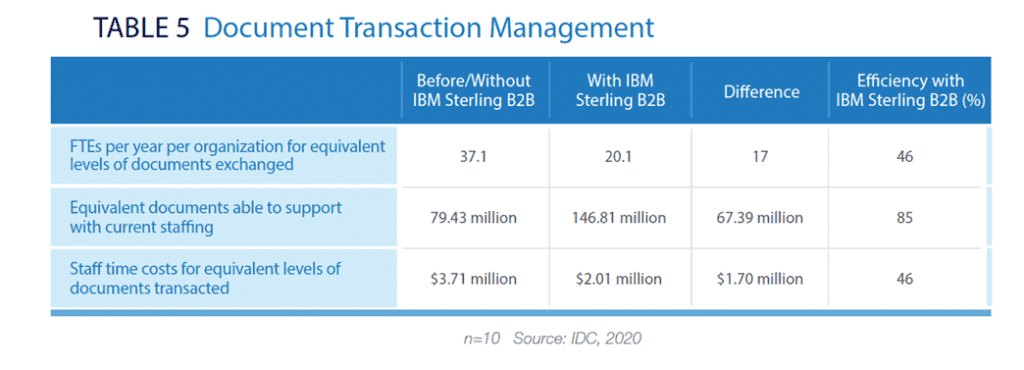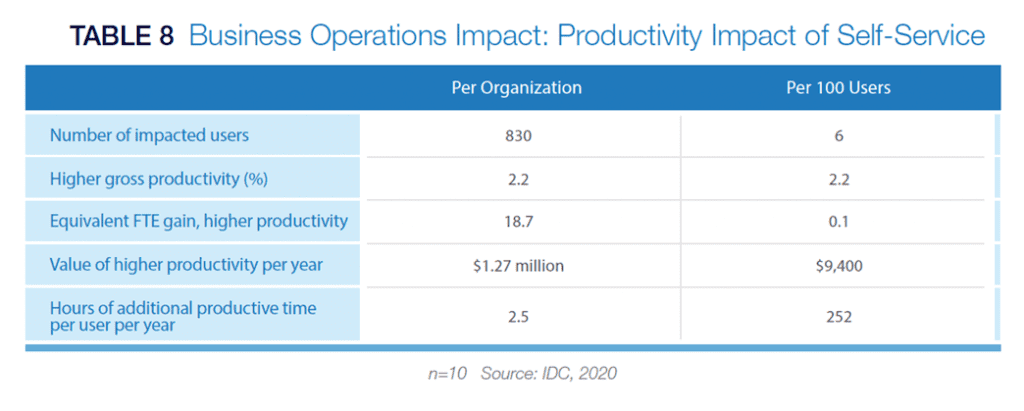
At the core of B2B integration middleware and MFT software is the exchange of documents between multiple parties, both internal and external to the enterprise. Data exchange requires onboarding, mapping, transport, monitoring, and management across the entire ecosystem of trading partners. The IBM Sterling B2B collaboration software portfolio enables the entirety of the data exchange process, delivering real business value to customers as the B2B processes of the past are expanding into the broader ecosystem in the digital economy.
Customers using IBM Sterling B2B integration and managed file transfer solutions (IBM Sterling B2B collaboration) were interviewed by IDC[i] to understand the impact on their B2B document transfer and business operations. These organizations’ businesses rely on the consistent, secure, and timely flow of documents and other information between their employees and partners, customers, and other third parties. Study participants reported achieving significant value with IBM Sterling B2B collaboration by improving business results and increasing their capacity and ability to exchange B2B documents. IDC calculates that study participants using IBM B2B Sterling will achieve benefits worth an annual average of $14.72 million per organization ($108,700 per 100 users and $291,900 per 100 trading partners) in the following areas:
- Higher revenue
- Risk-related benefits
- Efficiencies in managing B2B documents and file transfers
- IT staff efficiencies related to B2B operations
- Line-of-business productivity gains


1. Generating Higher Revenue:
Study participants reported that they are generating higher revenue with IBM Sterling B2B collaboration by better serving customers, addressing new business opportunities, and advancing revenue recognition. Among other factors, these improvements tie back to having more effective B2B and document exchange operations, including improved ability to onboard and work with partners critical to their business success.
Interviewed organizations underscored specific benefits such as the faster onboarding of partners, expanding the potential base of partners by offering compliance with EDI standards, and the ability to build better long-term relationships with their partner base. IDC quantified the specific improvements that the IBM Sterling B2B collaboration platform provides for onboarding new partners. Interviewed organizations reported needing only around 2.6 days on average to onboard a new business partner, a 45% improvement, and time savings of over two days on average. Interviewed companies also linked higher revenue to improved customer services enabled by IBM Sterling B2B collaboration, and they cited higher levels of B2B responsiveness and faster exchange of documentation.
Greater speed of execution and less complication in servicing customers and partners, including onboarding and invoicing, have helped interviewed IBM customers move forward with revenue recognition. In some cases, they have reduced a significant amount of time, going from weeks or months to days. The use of IBM Sterling B2B collaboration has also allowed interviewed organizations to take better advantage of new opportunities and operate more efficiently concerning their current books of business. The platform’s functionality has improved the speed and effectiveness of B2B transactions associated with core business activities.
The overall positive revenue impact for interviewed IBM customers using IBM Sterling B2B collaboration is summarized in the table below. IDC calculates that they will realize higher annual gross revenue worth $73.08 million per organization, representing a significant business gain.


2. Limiting Risk Associated with B2B Document Transfers
Study participants reported that IBM Sterling B2B collaboration offers them the capability to manage, track, and execute document transfers quickly and reliably. The platform’s design minimizes the occurrence of incomplete or problematic B2B transactions taking place at either the originating company or the customer or partner site. Reducing or eliminating these types of document-related problems has served to reduce business risk for interviewed companies significantly.
IDC quantified these reductions in unplanned downtime related to B2B operations, as shown in the table below. The data indicates the near elimination of lost productive time annually for interviewed organizations since deploying IBM Sterling B2B collaboration, demonstrating the robustness and reliability of the platform as a foundation for their businesses. By reducing the impact of unplanned outages on employees, interviewed organizations are losing 99% less productive employee time, which is worth annual productivity time savings of $1.89 million.


In addition, interviewed organizations noted that they could ill afford B2B platform outages because of the possibility of interrupting business operations, which includes the potential loss of revenue. By reducing business interruptions with IBM Sterling B2B collaboration, IDC calculates that study participants will avoid the loss of $7.45 million in revenue per year.
3. Managing Document Transfers Efficiently
Having a scalable and more efficient B2B platform with IBM Sterling B2B collaboration has allowed interviewed organizations to handle significantly more document transfers robustly to support business operations. These efficiencies relate to several areas of improvement with IBM Sterling B2B, including its ability to complete document transactions faster. By completing document transfers faster, interviewed organizations can better ensure timely delivery of required B2B documentation and handle increased document flow without needing additional team time. Study participants reported going from needing an average of almost 21 minutes to just over 8 minutes with IBM Sterling B2B collaboration for a typical document transaction, representing a significant improvement of 61% on average.
Another perspective on the impact of the use of IBM Sterling B2B collaboration for interviewed organizations is the timeliness of document delivery. It has reduced the frequency of documents not delivered promptly by 86%, going from around 14% to only 2% of documents. Timely delivery of B2B documentation is essential for several reasons, including interviewed organizations’ ability to onboard partners and new customers, recognize revenue, and communicate robustly with customers.
In addition to improvements in the speed and effectiveness of document delivery, study participants have improved the quality of document transmission with IBM Sterling B2B collaboration. This relates to features of the IBM Sterling B2B collaboration platform, such as data validation that applies business rules with graphical modeling to documents delivered to identify errors. Interviewed companies reduced the percentage of documents provided that had errors or quality problems from 3.1% to 0.6%, or an 80% reduction in the transmission of problem documents.
Interviewed organizations rely on the exchange of millions of B2B-related documents with their partners and customers every year. They have staff members involved in making sure that these documents are transacted effectively and with high quality. However, these efforts are hampered by a lack of visibility into their real-time status and problems that arise due to errors and complications requiring manual intervention. When these issues related to B2B documentation arise, they create friction and mean that more staff time is needed. IDC research showed that having a common platform with high performance and automation of document flow has allowed study participants to handle and move substantially more documents without a commensurate increase in staffing.
As shown in the table below, IDC calculated that interviewed companies were able to process 85% more documents with the same level of staffing with IBM Sterling B2B collaboration. This substantial productivity increase for document transaction management teams translates into an average annual value worth $1.70 million per interviewed organization.


4. More Efficient IT Support of B2B Organizations
Study participants also reported efficiencies for the IT teams involved in supporting and managing B2B operations and platforms. These efficiencies relate to features of the IBM Sterling B2B collaboration platform, such as enhanced automation, and to study participants’ ability to consolidate their B2B operations on a single platform. In some cases, interviewed IBM customers moved to IBM Sterling B2B collaboration from multiple tools that created inefficiencies in terms of costs and staff time required for management and support.
Study participants report that 54% fewer support staff team members are needed to carry out day-to-day operations involving B2B document transfer, given less frequent and easier to resolve issues related to document management and transactions. IDC quantifies the value of this improvement at an annual staff productivity value of $0.57 million per interviewed organization. Study participants also reported that the amount of IT staff time and involvement required for B2B platform operations have significantly reduced, resulting from Lines of Business (LOB) self-service access to documents and higher overall quality of the B2B platform. As shown in the table below, the use of IBM Sterling B2B collaboration has meant that interviewed IBM customers require 12 fewer IT staff members to manage and run the IT infrastructure behind their B2B operations, representing a 55% efficiency on average.


5. Enabling Lines of Business Through Higher Productivity
Line-of-business users at interviewed organizations have also benefited from various features of the IBM Sterling B2B collaboration platform, such as self-service access to documents and other B2B data. Message tracking and reporting features along with auditing capabilities using centralized dashboards allowed real-time status information to be available to system administrators, LOB users, and partners. These users benefitted from improved transaction visibility and can manage and monitor document transfer activities themselves without unnecessarily involving other support staff.
The table below quantifies the improvements made possible by IBM Sterling B2B’s self-service capabilities. On a per organization basis, an average of 830 LOB users have benefited from the use of self-service with IBM Sterling B2B collaboration, resulting in an average productivity gain of 2.5 hours per year per user, which is worth an average of $1.27 million in higher productivity per organization.


IDC’s research demonstrates the value that interviewed organizations are achieving by using IBM Sterling B2B Collaboration solutions. Overall, IDC calculates that interviewed IBM customers will achieve almost a four-to-one return of their investment in the IBM Sterling B2B Collaboration platform over three years (291% ROI), demonstrating the significant impact that it has had on study participants’ B2B operations and business activities.
Contact us for more details about the IBM Sterling Supply Chain Solutions.
[i] IDC White Paper, The Business Value of IBM Sterling B2B Integration and Managed File Transfer Solutions, September 2020

